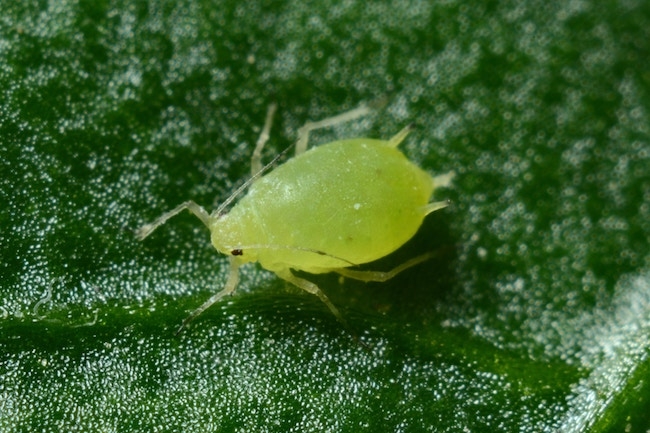
Features
Crop Protection
Inputs
Key tips on minimizing greenhouse pests
Pest Management Q&A with Charlie McKenzie and Allison Kopf.
October 28, 2019 By CropWalk Artemis

 Charlie McKenzie, CropWalk
Charlie McKenzie, CropWalk
What are the biggest pest management pain points today for commercial greenhouse operations?
First, it’s a challenge to keep up with ever-evolving regulations and new products. There are chemicals today—especially in Canada—that growers can’t use on food and cannabis crops, or even ornamentals. While consumer safety is paramount, regulations have eliminated the use of many pest control tools, which has left growers with fewer options.
Second, is an increased resistance amongst pests to chemicals. Growers have to apply chemicals more regularly, and in turn, pests become resistant. It’s a vicious cycle. Growers apply chemicals thinking they’re beneficial, and they’re actually having an opposite effect.
Third, there’s a massive shift in the general practice of pest management. Regulations and pest resistance have rendered the traditional spray-and-pray methodology ineffective or illegal. Consequently, growers must focus more on proactive preventive measures and relearn how to scout and monitor for pests before a major problem occurs.
What are the top one or two considerations any grower should make when tightening their pest management protocol?
The first step is for growers to understand the available tools including biocontrols. Some growers of higher margin crops like cannabis can use biocontrols at scale. But ornamental, leafy greens, and fruits and vegetables growers often must integrate traditional chemistry and biocontrols to stay cost effective. Understanding all available tools and how they interact will give growers a leg up.
The second step is to establish an objective scouting and monitoring program. Knowing what exists in a crop and being able to look at those trends regularly crop-over-crop, year-over-year is important. If a grower uses a biocontrol or chemical on aphids, they might kill most in that initial sweep, but you can’t stop there. Growers need to check on a weekly basis to gauge how effective the control method performs over time.
What are some common, and most costly mistakes growers make when trying to eradicate pests from their production?
One of the biggest mistakes is when growers integrate biocontrols into a program, but treat perishable beneficial insects as they would a chemical. Growers might order biocontrols once a month, but that’s not frequent enough for perishable biocontrols, which often require weekly shipments to remain effective.
Growers also have to ensure the biocontrol they ordered arrives alive. Many growers unknowingly apply dead or low quality beneficial insects to their crop. They receive a shipment, but skip quality assurance to verify the bugs arrived alive. Growers spend physical labor to apply dead bugs to crops, which is a massive and costly mistake.
Another mistake goes back to the regulatory issue. Growers that don’t pay attention to what’s on a label or regulations risk getting hit with a fine or a product rejection from a store. The produce safety industry—especially cannabis—is changing so fast that things go on and off the accepted list pretty quickly. Growers not in the know and up-to-speed could be applying something to a crop that’s going to leave it void of any value.
How does pest management fit into the larger picture of cultivation management and reducing risk to greenhouse operations from both a profitability and compliance standpoint?
Pest management is probably the one variable that’s impossible for growers to control. It’s possible to figure the proper irrigation strategy down to the milliliter. Growers can make decisions about that strategy by controlling for variables like the weather, time of year, and crop age.
But you can’t control every variable with pest management. You can’t control how the bad bugs enter your greenhouse. If you have a completely closed system and nothing can get in, that’s one thing. But most operations can’t say with certainty they don’t have aphids or spider mites in their crop. You can’t yank a water valve and turn off pests; they’re a variable that’s uncontrollable. You have to look at it on a weekly basis, and it’s not going to be the same year-over-year or even crop-over-crop.
Knowing that pests will throw curve balls at you and having a contingency plan are what’s going to possibly save you from reducing profitability on the compliance side. Many crops have restrictions on what can be on the plant at time of sale. From my experience in the ornamentals business, I would ship a truck that would have certain pests on it and they would send it back. We wouldn’t get credited for that money and it would be a total loss. Growers need to hedge their bets from the beginning by having a pest management plan in place, which could prevent major potential financial losses.
What are some common links between insects that cause damage both by feeding on plants, but also by spreading diseases and how can both be controlled by proactive insect control?
Certain insects like fungus gnats can open up the roots to a challenge in soil borne diseases. They pierce the surface of the roots while feeding, and then in overly moist conditions, this allows pythium to develop. Thrips and aphids both transmit viruses. Having aphids and thrips in your crop might mean you are at risk of a virus being transmitted to your crop. It can certainly be a cause-and-effect relationship between insects and disease.
Controlling aphids, thrips, and fungus gnats up front is not only going to prevent pest damage that’s either aesthetically displeasing or that reduces yields, but it also might prevent a virus or pathogen that would be transmitted by those pests. Piercing and sucking mouthparts on insects can give the insect the ability to be a vector and transmit some sort of pathogen. Preemptive pest control can alleviate some of these potential issues.
 Allison Kopf, Artemis
Allison Kopf, Artemis
What are some key practices during the cultivation stage for greenhouse operations that can minimize the risk and/or buildup of pest infestations?
Controlling pests in greenhouses and other controlled environments is a critical component of a larger cultivation management strategy aimed at reducing operational and financial risk, as well as maintaining regulatory compliance. While crop damage and contamination can always occur post harvest, common pests including thrips, aphids, spider mites and various molds and diseases infest and attack plants during cultivation between seed and harvest.
Many growers have widely adopted Integrated Pest Management (IPM) as a system of best practices to fight pests. IPM employs a variety of cultural, chemical, and biological controls during cultivation to minimize overall risk and prevent any buildup of infestations.
Simple, proactive tactics such as facility maintenance and sanitation can play a huge role in preventing pests or pest buildup. For instance, one of the biggest issues in pest management is cross contamination. Moving plants from cultivation zones to harvesting zones can promote the spread of disease and pests throughout the greenhouse. Some of this can be mitigated before operations start, by designing the facility with separate harvest and vegetative rooms where plants are moved in a single direction, rather than back and forth. This isolates pests and prevents them from contaminating entire batches.
What is the role that technology, data, and automation can play in the early detection and diagnosis (and associated labor) for greenhouse pest management?
Pest control professionals are beginning to adopt mobile devices to get real-time data about the nature and severity of pest problems. They can host the data online or in the cloud for facility managers, laborers, and pest control professionals to easily access and evaluate. This allows the facility to identify issues quickly and be agile in their response.
As an early detection tool, the use of this automated technology and real-time data allows facility managers to deploy labor more strategically. Imagine you have 300 acres with people physically walking around counting bugs on sticky traps. That is wildly inefficient and wastes money and labor hours. These devices free up time that would otherwise be spent on the painful process of manually patrolling crops, but they also allow facility managers to identify precisely where labor needs to be deployed to fight early pest infestations or disease.
Furthermore, real-time data can allow growers to take preventative actions to avoid infestations and disease before they even develop. With ever increasing measurements of new integrated data points (e.g. being able to measure the presence of harmful airborne spores) growers can not only make decisions more quickly, but they can make the right decisions.
What are some of the innovative technologies and solutions on the market today for pest control that greenhouse operations should be looking at?
Koppert Biological Systems is a leading pest management company that offers a complete program of products and services for Integrated Pest Management. It provides a mobile app that can take pictures of sticky cards and identify bug count and type. One of their solutions is an integrated mobile iPM (intelligent pest management) app and dashboard for more efficient scouting, which is a significant part of pest management. The app uses GPS outdoors for mapping, and real time data from the field showing what pests exist where saves time on scouting, allowing for fast and targeted decision making.
Another innovative company in the pest control space is Scanit Technologies, an Artemis partner. Scanit uses sensors to detect airborne particles and spores. These are analyzed against common spores known to be dangerous to particular crops in the greenhouse. If hazardous spores are identified, Scanit relays this information to growers, who can then act before a fungus or disease problem even fully materializes.
Why is having a Cultivation Management Platform (CMP) a critical part of pest management, and what gaps does it cover that an existing ERP doesn’t?
ERPs are great at aligning horizontal functions like payroll, billing, inventory tracking, logistics, etc. The downside is they are expensive, difficult to implement and most importantly aren’t industry specific. This is critical when it comes to pest management, because a CMP allows growers to sync and track all of their pest control data along every point from seed-to-harvest.
Once a grower has identified the source or cause of a pest-related problem, a CMP provides full traceability, allowing growers to go through their data and understand what specific action they need to take to eliminate the problem. With a CMP, growers can truly manage risk and compliance by tracking precisely where a problem arose and understand how far it spread. It doesn’t matter what you grow or how you grow it, all crops are vulnerable to pests, and an ERP can’t help manage this risk to product and profits.
On the labor side, greenhouse facility managers can even track what employees were on site and in which areas where the disease or pests originated or spread. Rather than losing an entire batch due to a small, isolated pest issue or disease that has gone untracked, a CMP can show growers precisely what plants need to be destroyed and which ones don’t, saving growers huge amounts of time and money.
Print this page